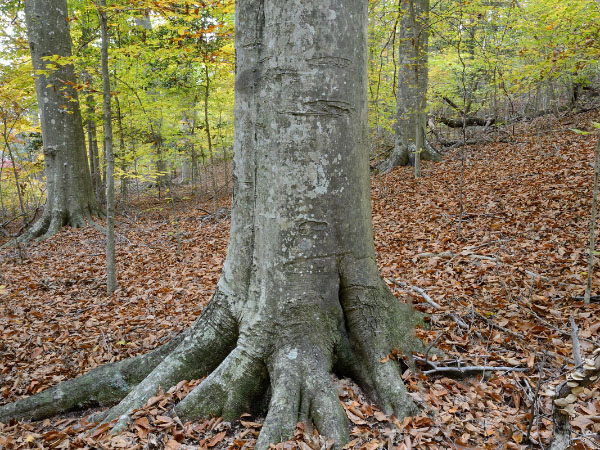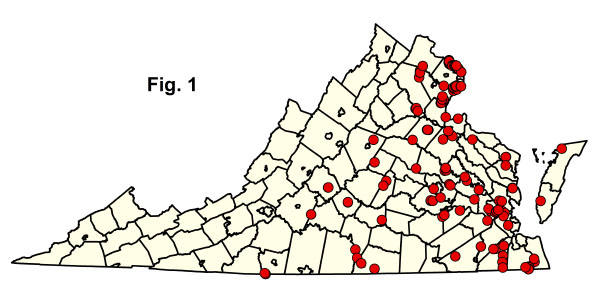

Virginia Department of Conservation and RecreationAn official website of the Commonwealth of Virginia Here's how you knowAn official websiteHere's how you know

Virginia Department of Conservation and RecreationAn official website of the Commonwealth of Virginia Here's how you knowAn official websiteHere's how you know
 Department of Conservation and Recreation
Department of Conservation and Recreation
 Table of Contents
Table of ContentsMesic Mixed Hardwood Forests
These mixed hardwood forests are widespread in mesic to submesic, infertile habitats throughout the Coastal Plain and Piedmont. Forests in this group occupy mesic uplands, ravines, lower slopes, and well-drained "flatwoods" on deep, acidic, relatively nutrient-poor soils. The most typical overstories contain mixtures of American beech (Fagus grandifolia), oaks (Quercus spp., varying by region), tulip-tree (Liriodendron tulipifera), and hickories (Carya spp.), but a wide variety of hardwood associates occur. American hornbeam (Carpinus caroliniana ssp. caroliniana and ssp. virginiana), flowering dogwood (Cornus florida), American strawberry-bush (Euonymus americanus) and American holly (Ilex opaca var. opaca) are prominent understory plants. In mesic "flatwoods" or "swamp islands" of the southeastern Virginia Coastal Plain, silky camellia (Stewartia malacodendron) and big-leaf snowbell (Styrax grandifolius) are characteristic small trees. These communities lack the lush herbaceous layers of Basic Mesic Forests, although species such as Christmas fern (Polystichum acrostichoides), New York fern (Parathelypteris noveboracensis), and white wood aster (Eurybia divaricata) may form moderately dense populations. Along with Christmas fern, downy rattlesnake-plantain (Goodyera pubescens), Virginia heartleaf (Hexastylis virginica), and partridge-berry (Mitchella repens) are frequent evergreen herbs in mesic mixed hardwood forests. The name "Southern Mixed Hardwood Forest" has been applied to some Coastal Plain representatives of this group. Although mesic mixed hardwood forests still cover sizeable areas east of the mountains in Virginia, their extent and compositional integrity have been reduced by agriculture, development, and repeated logging.
References: Abrams and Copenheaver (1999), Adams et al. (2003), Coulling (1999), Crouch (1990), DeWitt and Ware (1979), Fleming (2002a), Fleming (2002b), Fleming et al. (2007), Frost and Musselman (1987), McCoy and Fleming (2000), Monette and Ware (1983), Plunkett and Hall (1995), Walton et al. (2001), Ware (1970), Ware (1978), Ware (1991), Wolff and Ware (1994).
Click here for more photos of this ecological community group.
 © DCR-DNH, Gary P. Fleming.
© DCR-DNH, Gary P. Fleming.
This group is represented by 170 quantitative plot samples (Fig. 1), most of them supporting the first of the two classified types. Representatives of this group in the southeastern Virginia Coastal Plain, although clearly distinct, need more documentation and clarification of their regional affinities. The Northern Coastal Plain / Piedmont Type encompasses some compositional variation related to geography, as well as a considerable gradient in apparent site moisture potential, from that of very mesic ravine bottoms to that of submesic, convex upper slopes and crests. Nevertheless, attempts to split this unit into two or more types or subtypes have proven difficult to justify on the basis of floristic composition, despite the availability of ample quantitative data. Click on any highlighted CEGL code below to view the global USNVC description provided by NatureServe Explorer.

 Download a spreadsheet of compositional summary statistics (Excel) for each of the community types listed below.
Download a spreadsheet of compositional summary statistics (Excel) for each of the community types listed below.

